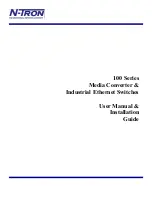
374
type and Internet-access customer.
MT-RJ connector.
A type of fiber-optic cable jack that is similar in shape and concept to a standard
telephone jack, enabling duplex fiber-optic cables to be plugged into compatible devices as easily as
plugging in a telephone cable.
MUX.
See “Multiplexing” on page 299.
N
NAT.
See “Network Address Translation” on page 299.
Network Address Translation.
Sometimes referred to as Transparent Proxying, IP Address
Overloading, or IP Masquerading. Involves use of a device called a Network Address Translator, which
assigns a contrived, or logical, IP address and port number to each node on an organization's internal
network and passes packets using these assigned addresses.
NM.
Network Module.
nm.
Nanometer (1 x 10e
9
) meters.
non-stub area.
Resource-intensive OSPF area that carries a default route, static routes, intra-area routes,
inter area routes, and external routes. Non-stub areas are the only OSPF areas that can have virtual links
configured across them, and are the only areas that can contain an ASBR. Compare with stub area. See
also ASAM and OSPF.
NP.
Network Processor.
O
Open Shortest Path First.
A link- state (algorithm used by the router to determine the current topology of
a network), Interior Gateway (distributes routing information between routers belonging to a single
Autonomous System) routing protocol. This protocol's algorithm determines the shortest path from its
router to all the other routers in the network. This protocol is rapidly replacing RIP on the Internet.
Open Systems Interconnection.
OSI is a seven (7) layer architecture model for communications
systems developed by the ISO for the interconnection of data communications systems. Each layer uses
and builds on the services provided by those below it.
Operating System Application Programming Interface.
OSAPI is a module within the System Support
software that provides a set of interfaces to OS support functions.
OS.
Operating System.
OSAPI.
See “Operating System Application Programming Interface” on page 300.
OSI.
See “Open Systems Interconnection” on page 300.
OSPF.
See “Open Shortest Path First” on page 300.
P
PDU.
See “Protocol Data Unit” on page 300.
PHY.
The OSI Physical Layer: The physical layer provides for transmission of cells over a physical
medium connecting two ATM devices. This physical layer is comprised of two sublayers: the Physical
Medium Dependent (PMD) sublayer, and the Transmission Convergence (TC) sublayer.
PIM-DM.
See “Protocol Independent Multicast – Dense Mode” on page 300.
PMC.
Packet Mode Channel.
Содержание DN-80233
Страница 1: ...User Manual Dynamic 24 PORT MANAGED GIGABIT SWITCH DN 80233 ...
Страница 25: ...24 ...
Страница 28: ...27 ...
Страница 29: ...28 ...
Страница 30: ...29 ...
Страница 31: ...30 ...
Страница 107: ...106 and no spaces use a hyphen to designate a range of IDs For example you may set vtrunk set 1 2 5 8 ...
Страница 149: ...148 Default 0 Format vlan priority priority Mode Interface Config ...
Страница 224: ...223 Mode Class Map Config ...
Страница 293: ...292 11 6 51 1 no trapflags This command disables OSPF traps Format no trapflags Mode Router OSPF Config ...




































